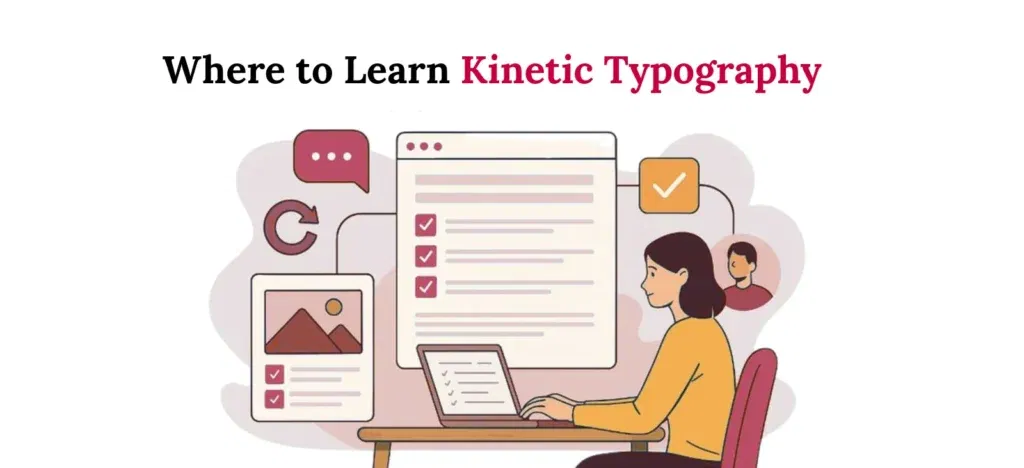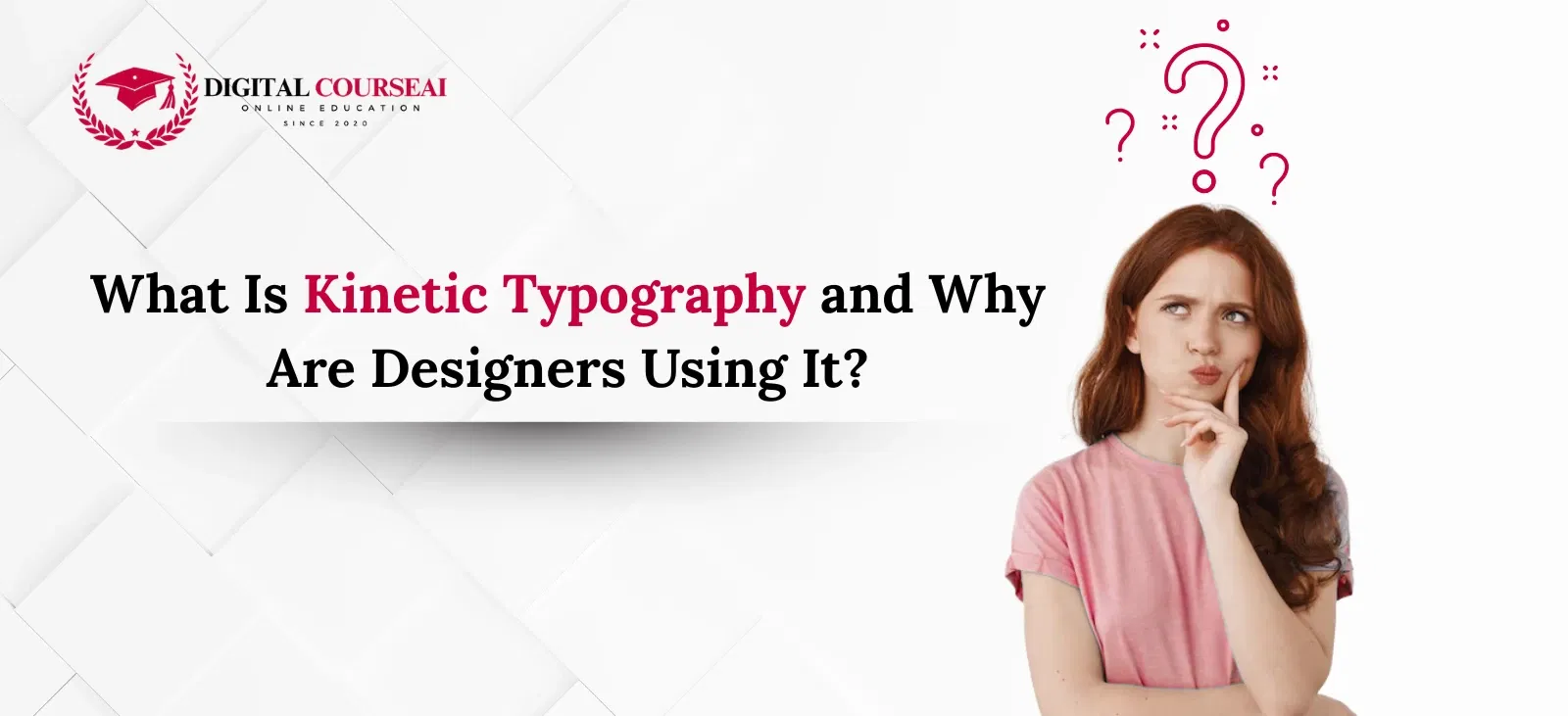Kinetic typography is the art of making text move. It’s a design technique where animated text is used to capture attention, convey emotions, and enhance storytelling. In the digital world, where people scroll quickly and attention spans are short, kinetic typography helps brands and creators deliver messages in an engaging way.
From YouTube videos and movie trailers to websites and social media ads, you’ve probably already seen kinetic typography in action. Imagine bold letters bouncing to the beat of a soundtrack, words flying across the screen to match voiceovers, or phrases expanding and fading to emphasise key points. These animated motions add visual drama, reinforce tone, and often increase viewer retention.
Designers prefer kinetic typography not just for its creativity but also because it improves communication. A strong message paired with motion captures attention far more effectively than static text. It also allows designers to control pacing, leading the viewer’s eye exactly where they want it to go. In UI/UX projects, kinetic typography helps create micro-interactions, explain features, and offer onboarding instructions without cluttering the interface.
The Power of Visual Language in Modern UI Design
Text is more than just a string of letters. In design, typography sets the tone, mood, and personality of the brand. But when you add motion to that text—through kinetic typography—it becomes a living, expressive part of the interface. It’s no longer just about reading; it’s about experiencing.
For instance, in an app walkthrough or product intro screen, instead of overwhelming users with long blocks of instructions, designers use short, animated texts to guide users step-by-step. The movement adds life to the message and keeps the user’s interest intact. This strategy works well in modern UI/UX design where functionality and aesthetics are equally important.
Apps like Duolingo, Spotify, and Netflix use kinetic typography to inform and engage users, often creating memorable moments through subtle text animations. These little details, though small, contribute to the overall user experience. And that’s what UI/UX design is all about—building user-friendly, emotionally engaging interfaces.
Kinetic Typography in Advertising and Social Media
In the competitive world of digital marketing, brands are constantly looking for ways to stand out. Kinetic typography offers a simple yet powerful tool to make content more dynamic and compelling. Unlike static posts, animated typography can communicate messages in a few seconds, making it ideal for short video ads, Instagram reels, YouTube intros, and banner ads.
Many companies now use motion graphics with kinetic text to deliver brand messages with a punch. Whether it’s a motivational quote, a sales offer, or an event announcement, animated text grabs attention and holds it. Studies have shown that videos with animated text have higher engagement rates than plain videos. This makes it a valuable tool for social media managers, digital marketers, and content creators.
For aspiring UI/UX designers, learning how to use kinetic typography gives you a unique advantage. It blends design skills with motion thinking. You learn how to animate with purpose, ensuring that every movement aligns with the brand’s voice and audience expectations.
The Role of Kinetic Typography in UX Writing and Micro-Interactions
UX writing is the language of the interface. It’s what guides users, informs them, and nudges them to take action. When combined with motion, UX writing becomes more impactful. For example, a loading screen that says “Just a moment…” with a soft bounce effect adds patience and delight to a usually boring wait. A confirmation like “Message Sent!” that slides or pops onto the screen gives users visual reassurance.
These are called micro-interactions—small design details that create emotional responses. Kinetic typography plays a big role here. Designers use it to:
- Provide feedback (e.g., success or error messages)
- Offer guidance (e.g., animated tooltips or hints)
- Create transitions (e.g., page titles that animate as you scroll)
These tiny movements can influence the user’s perception of the app. They make the experience feel smoother, friendlier, and more interactive. For any UI/UX designer, mastering kinetic typography means you’re not just designing a look—you’re designing behaviour.
How Designers Create Kinetic Typography
Creating kinetic typography involves both creativity and technical skills. Designers typically use tools like:
- Adobe After Effects: The industry-standard for creating motion graphics
- Figma + Figmotion Plugin: For basic motion prototyping
- Lottie + Bodymovin: To export lightweight animations for websites or mobile apps
- Canva and Adobe Express: Quick tools for social media motion design
The process starts with writing the copy—short, sharp, and clear. Then comes typography—choosing fonts, sizes, spacing, and layout. Finally, motion is applied based on the message’s tone. Is it playful? Then, bouncing or rotating letters may work. Is it serious? A subtle fade or scale animation might be more appropriate.
Designers also focus on timing and rhythm. The text should move in sync with the music, narration, or interaction. It’s a mix of storytelling and choreography. That’s why kinetic typography sits at the intersection of design, motion, and communication.
Where to Learn Kinetic Typography as Part of UI/UX Design

If you’re someone who loves creativity, storytelling, and tech, kinetic typography is an exciting skill to learn. But it’s even better when taught in the context of user interface design. That’s why joining a structured course helps you understand both the art and the strategy behind motion design.
Digital CourseAI offers one of the most practical and comprehensive UI/UX courses in Gurgaon. This course covers:
- Typography and layout principles
- Motion design basics and tools
- Real-world UI/UX projects
- Animated onboarding and micro-interactions
- Adobe tools, Figma animations, and design thinking
Students also work on portfolio projects that include kinetic typography, giving them hands-on experience. More importantly, the institute prepares learners for actual design jobs, not just theory-based exams. The mentors are industry experts, and the learning environment is collaborative.
If you’re in Delhi-NCR and looking for career-oriented training, this UI/UX course in Gurgaon will help you gain both design and motion skills in one go. For more information, check out: UI/UX course in Gurgaon
Job Roles and Career Benefits of Learning Kinetic Typography

Once you master kinetic typography, you open doors to multiple career roles, including:
- UI/UX Designer
- Motion Graphic Designer
- Visual Designer
- Interaction Designer
- Video Content Creator
Employers today want designers who can do more than just make screens look good. They want communicators—people who can tell stories visually, drive engagement, and solve user problems. With kinetic typography in your toolkit, you bring movement to static screens, making products feel more alive and user-friendly.
Even freelance designers and content creators benefit. You can design animated posts, YouTube intros, or brand videos and charge anywhere between ₹5,000 to ₹30,000 per project, depending on complexity. As your portfolio grows, so does your reputation and earning potential.
Conclusion: Kinetic Typography Is the Future of UI and Storytelling
To sum it up, kinetic typography is not just a trend—it’s the future of digital storytelling. It blends the power of motion with the simplicity of text to create designs that speak louder and clearer. For designers, marketers, and students alike, learning kinetic typography is a gateway to more expressive and engaging content.
And there’s no better way to learn than from the experts. Digital CourseAI’s UI/UX course in Gurgaon equips you with all the practical knowledge, hands-on skills, and creative mindset needed to thrive in the design industry.
Whether you’re a beginner or someone looking to switch careers, kinetic typography will give you a solid edge. It’s time to go beyond static and start creating smart, dynamic designs that move people—literally.
Want to design what moves the world? Explore the course now: UI/UX course in Gurgaon
FAQs About Kinetic Typography and UI/UX Design
1. What is kinetic typography in UI design?
Kinetic typography is the use of animated text to create visual interest and communicate messages effectively. In UI design, it helps guide users, provide feedback, and improve the overall user experience.
2. Why should designers learn kinetic typography?
Designers should learn kinetic typography because it enhances storytelling, engages users, and creates more interactive and visually appealing interfaces. It also improves a designer’s ability to communicate ideas clearly.
3. Where can I learn kinetic typography as part of UI/UX?
You can learn kinetic typography through a structured UI/UX course. One of the best places to start is Digital CourseAI’s UI/UX course in Gurgaon, which covers motion design as part of its curriculum.
4. Is kinetic typography used in mobile apps and websites?
Yes, kinetic typography is commonly used in both mobile apps and websites for onboarding screens, promotional banners, micro-interactions, and instructional content.
5. Do I need coding skills to use kinetic typography?
Not necessarily. Many design tools like Adobe After Effects, Figma plugins, and Canva allow you to create kinetic typography without advanced coding skills.
6. What careers can I pursue after learning kinetic typography?
You can pursue careers as a UI/UX designer, motion graphic designer, visual designer, or interaction designer. These roles are in demand across the tech, media, and advertising industries.
7. How is kinetic typography taught in Digital CourseAI’s UI UX course in Gurgaon?
Digital CourseAI integrates kinetic typography into practical design projects. Students learn to animate text using modern tools and apply it within real-world user interface designs, ensuring job-readiness upon course completion.

